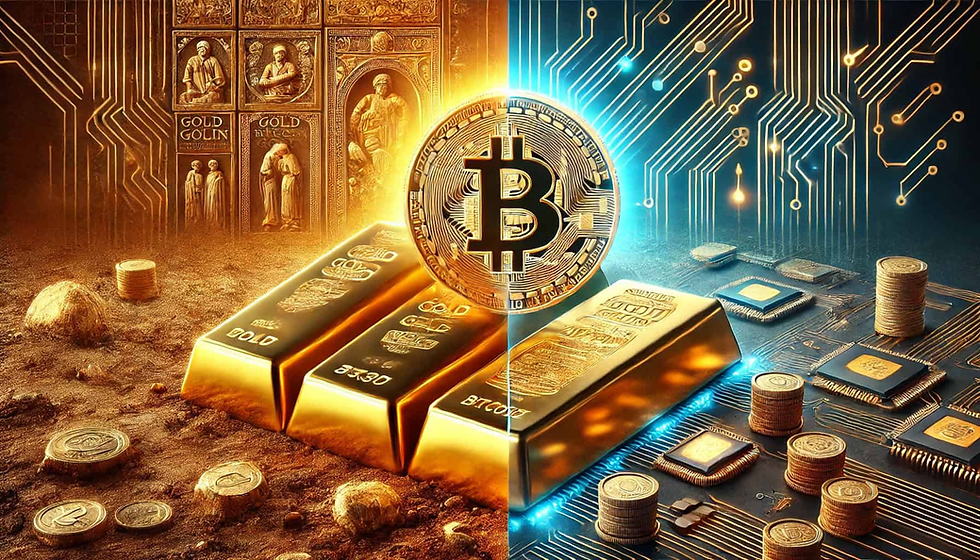Bitcoin: Rethinking Money in the Digital Age
- Nicholas Blikstad

- Sep 28
- 3 min read

Have you or your family ever had your credit card stolen, been scammed online, or faced surprise bank fees? You’re not alone. In fact, nearly two-thirds of U.S. credit card holders have been targeted by fraud at some point.
These problems highlight one of the biggest weaknesses in today’s financial system: trusting middlemen like banks and credit card companies to handle your money. They store your information, process your payments, and sometimes charge you extra for the privilege all while still leaving you exposed to theft and mistakes.
Now imagine a type of money where these risks are significantly smaller. A currency that doesn’t need banks to move it, can’t easily be hacked, and allows people to send value directly to one another across the globe. That’s the power of Bitcoin.
What Is Bitcoin?
Maybe you've heard the concept or the term, Bitcoin, but do you know what it truly stands for and how it works?
Bitcoin is a digital form of money that exists only online. Created in 2009 by the mysterious Satoshi Nakamoto, Bitcoin was designed as a “peer-to-peer electronic cash system.”

Unlike traditional money, Bitcoin isn’t printed by a government or issued by a central bank. Instead, it is powered by thousands of computers all over the world working together through a system called the blockchain.
The blockchain is the foundation of Bitcoin. Think of it as a giant public notebook that everyone can read but no one can erase or edit. Every time someone makes a Bitcoin transaction it gets added to this notebook. Once written, it’s permanent. This ensures safety because the blockchain is stored on thousands of computers worldwide, it’s nearly impossible to hack or shut down.
It is decentralized meaning no single government, bank, or company controls it. The system runs itself through technology and math.
How does Bitcoin really work and how do people use it?
Peer-to-Peer Payments mean you can send Bitcoin directly to someone else. If you want to send money to a friend overseas, you don’t need to wait days for a bank transfer or pay expensive fees. The Bitcoin network processes it directly, usually in minutes.
Furthermore, through the process of mining new Bitcoins enter circulation through a process called mining. Imagine a huge global math contest where powerful computers race to solve complex problems, and the winner gets rewarded with new Bitcoins. This not only creates new coins but also keeps the blockchain secure and updated.

Unlike coins and bills, you can’t physically hold a Bitcoin. Its value comes from supply and demand. Only 21 million Bitcoins will ever exist, and this scarcity makes it valuable making it similar to gold.
Bitcoin has different uses depending on who you are and where you live. Many people see Bitcoin as an investment, similar to stocks or gold. It’s one of the most liquid assets in the world, meaning it can be quickly converted into cash or other assets.
Not long ago, using Bitcoin to buy something simple, like a cup of coffee was unrealistic. But today it’s becoming more common and easier. More shops, restaurants, and even online platforms are beginning to accept Bitcoin as payment. Also, Bitcoin ATMs are appearing worldwide, letting people exchange cash for Bitcoin on the spot.
The Risks of Bitcoin
Despite its many advantages, Bitcoin also comes with risks. Its price is highly volatile meaning it can rise by thousands of dollars in a single month and drop just as quickly. Transactions are irreversible meaning that once you send Bitcoin, you cannot cancel or reverse it. If you accidentally transfer funds to the wrong address, that money is lost permanently. To protect your Bitcoin, it’s essential to understand how digital wallets work, whether you choose the convenience of a hot wallet or the stronger security of a cold wallet.
The Future of Bitcoin
Right now, Bitcoin’s price is about $115,300 (September 16th, 2025). Some believe this is only the beginning, predicting Bitcoin will “go to the moon.” Others remain skeptical but what's clear is that Bitcoin has already achieved something remarkable which is that it has forced the world to rethink what money is and what it could be.
References
Interview with Axel Blikstad, CFA of B2V Crypto
"Bitcoin: Why Was It Created?" Crypto.com, https://crypto.com/en/bitcoin/why-was-bitcoin-created.
Nakamoto, Satoshi. Bitcoin: A Peer-to-Peer Electronic Cash System. Bitcoin.org, https://bitcoin.org/bitcoin.pdf.
"NortonLifeLock Credit Card Fraud Statistics." NortonLifeLock, https://lifelock.norton.com/learn/credit-finance/credit-card-fraud-statistics?srsltid=AfmBOooNMczvCEj4BIhKxPeP_zwfm1eYhdumT80_mrTr74DVwfymSGzB.
"Understanding Cryptocurrency." Kaspersky Resource Center, Kaspersky, https://www.kaspersky.com/resource-center/definitions/what-is-cryptocurrency.
"What Is Cryptocurrency?" BBC Bitesize, https://www.bbc.co.uk/bitesize/articles/zfsvy9q.






Comments